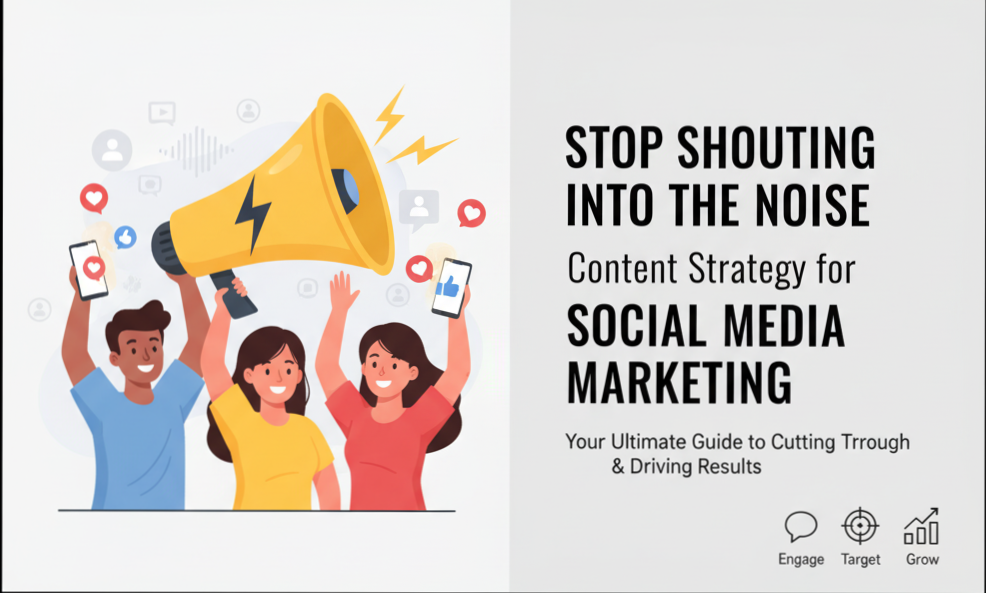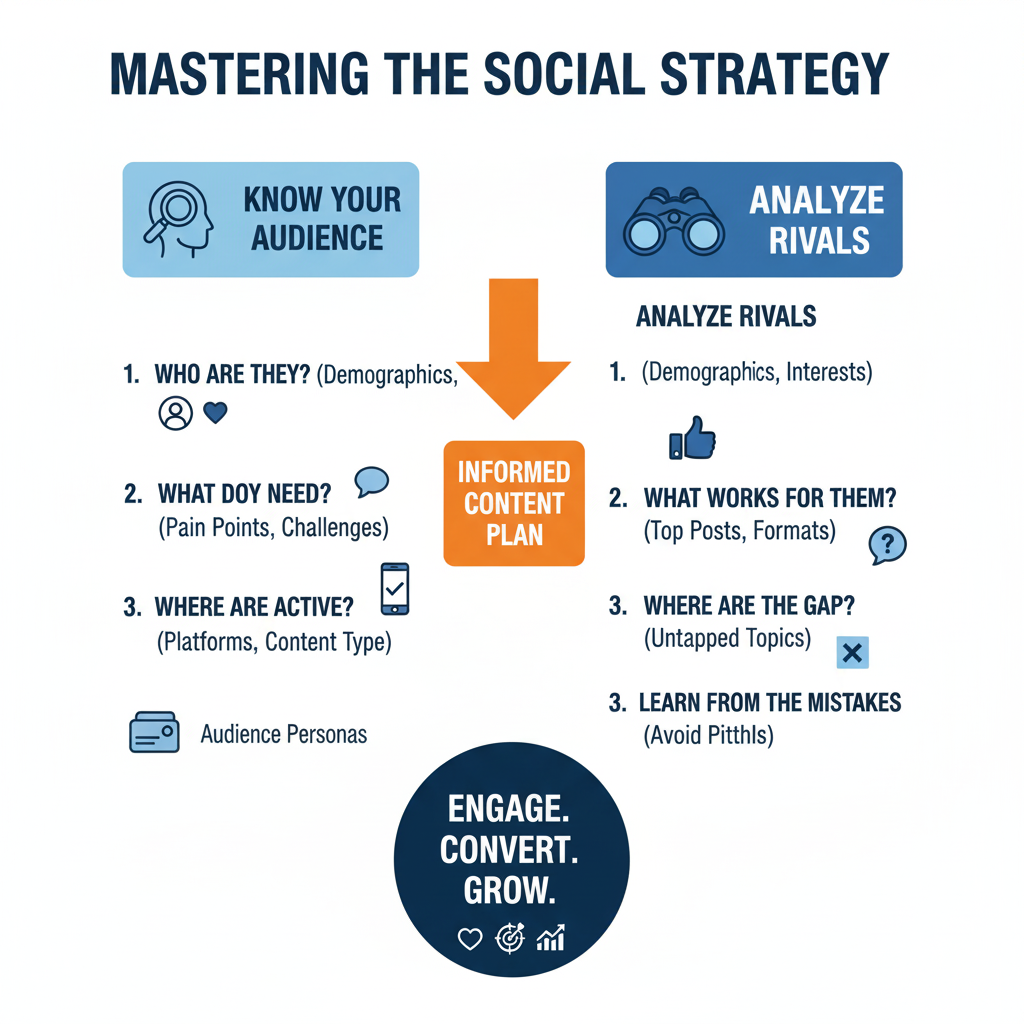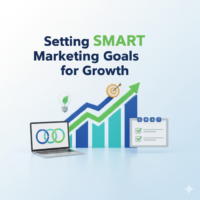Content Strategy for Social Media Marketing: The Winning Guide
Published: 4 Oct 2025

A strong content strategy for social media marketing helps you grab attention, engage your audience, and drive results. It’s not just about posting regularly—it’s about posting with purpose.
The field of social media is extremely crowded. Millions of posts are published daily, making it harder for brands to stand out. If your content isn’t planned well, it gets lost in the noise.
In this guide, you’ll learn how to improve your content strategy step by step. From setting clear goals to distributing content effectively, we’ll cover everything you need to attract, engage, and grow your audience.
Define Your Social Media Goals & Objectives
Without clear goals, your social media efforts will not yield results. You need a clear direction to know what works and what doesn’t. Setting the right goals helps you stay focused and measure success.
Why Goal-Setting is Crucial
- It guides your content strategy and ensures consistency.
- It helps you track progress and improve performance.
- It prevents wasted effort on content that doesn’t align with your brand.
Use SMART Goals for Better Results
A decisive goal follows the SMART framework:
- Specific – Define precisely what you want (e.g., increase engagement).
- Measurable – Use numbers to track success (e.g., gain 5,000 new followers).
- Achievable – Set realistic goals based on your resources.
- Relevant – Align goals with your brand’s vision.
- Time-bound – Set deadlines (e.g., increase shares by 30% in three months).
Align Social Media Goals with Business Objectives
Your social media content should support your business goals. You need to create posts highlighting products and customer reviews. If you want to build trust, focus on educational content and engagement.
A well-defined goal keeps your strategy organized, effective, and results-driven. Set clear goals today, and your social media content will start working for you!
Know Your Target Audience
Creating content without knowing your audience is like throwing darts in the dark. To succeed, you must understand who your audience is, what they want, and how they interact online.
Understand Their Demographics, Behaviors, & Pain Points
- Who are they? Look at age, gender, location, and interests.
- What do they need? Identify their challenges and frustrations.
- Where do they spend time online? Some prefer Instagram, others LinkedIn.
- How do they engage? Do they like videos, memes, or blog posts?
Use Social Media Insights & Analytics Tools
Social media platforms provide valuable data. Use:
- Facebook Audience Insights to see user preferences.
- Instagram & Twitter Analytics to track engagement.
- Google Analytics to understand where visitors come from.
Check which posts perform best. See what gets likes, shares, and comments. Adjust your content based on these insights.

Create Audience Personas for Better Engagement
An audience persona is a fictional profile of your ideal follower. It includes their age, job, interests, and online behavior, helping you create content that speaks directly to them.
When you truly understand your audience, your content will connect, engage, and convert better!
Competitive Analysis: Learn from Your Rivals
Social media is competitive. Brands fight for attention every second. To stand out, you need to learn from your competitors and improve your content strategy.
Why Analyzing Competitors Gives You an Edge
Competitor research helps you understand industry trends and identify what works best. It allows you to:
- See what type of content drives engagement in your niche.
- Avoid mistakes your competitors make and improve your strategy.
- Discover content gaps and create better posts.
Ignoring competitors means missing opportunities. Analyzing them allows you to refine your content, stay ahead, and attract more engagement.
Best Tools to Analyze Social Media Competition
Use these tools to track competitor performance and gain insights:
- BuzzSumo – Find the most shared content in your industry.
- Sprout Social – Tracks engagement, reach, and social media growth.
- SEMrush Social Media Tracker – Compares multiple competitor accounts.
How to Spot Content Gaps & Opportunities
- Look for trending topics competitors haven’t covered.
- Check their low-engagement posts and create better versions.
- Study their most shared content and find ways to improve it.
Competitor analysis helps you adjust your content strategy and create high-performing posts. The more you study your competitors, the better your social media results will be!
Conduct a Social Media Content Audit
A social media content audit is like a health check for your strategy. It helps you identify what’s working, what’s not, and what needs improvement. Without it, you might be posting content that doesn’t deliver results.
Why You Need a Social Media Content Audit
- Find out which posts perform best and repeat their success.
- Identify weak content and improve or remove it.
- Ensure consistency in branding, tone, and engagement.
- Track audience behavior to refine your approach.
Key Metrics to Analyze
When auditing your content, focus on these critical metrics:
- Engagement Rate – Likes, comments, shares, and overall interaction.
- Click-through rate (CTR) – How often users click on links in your posts.
- Conversions – Do posts lead to sign-ups, sales, or other actions?
- Reach & Impressions – How many people see your content?
Best Tools for Social Media Audits
Use these tools to track and analyze your content:
- Google Analytics – Tracks traffic from social media to your website.
- Hootsuite Analytics – Measures engagement and post-performance.
- Facebook & Instagram Insights – Shows detailed audience and reach data.
A regular content audit helps you remove what doesn’t work and focus on what drives engagement. This ensures your social media strategy stays fresh, compelling, and result-oriented!
Develop a Powerful Social Media Content Plan
A strong content plan keeps your social media strategy organized, engaging, and effective. Without a plan, your posts may feel random and fail to connect with your audience.
Choose the Right Content Formats
Different types of content attract different users. The correct format depends on your audience and platform. Some practical options include:
- Videos – Great for storytelling, tutorials, and behind-the-scenes content.
- Infographics – Perfect for sharing data, facts, and quick insights.
- Blogs & Articles – Provide in-depth knowledge and drive website traffic.
- Reels & Short Clips – Boost engagement with fast, visually appealing content.
Create a Mix of Engaging Content

Your content should educate, entertain, or inspire your audience. A well-balanced strategy includes:
- Educational – Tips, tutorials, how-to guides.
- Entertaining – Memes, fun challenges, and interactive posts.
- Inspirational – Success stories, motivational quotes, customer testimonials.
Adapt Content for Each Platform
Each platform has its unique audience and style:
- Instagram & TikTok – Focus on short videos, stories, and reels.
- Facebook & LinkedIn – Mix articles, images, and discussion posts.
- Twitter – Use short, engaging text with trending hashtags.
- Pinterest – Share high-quality images and infographics.
A well-planned content strategy ensures consistency, keeps your audience engaged, and helps grow your social media presence!
Creating & Managing a Social Media Content Calendar
A content calendar is a planning tool that helps you organize your posts in advance. It ensures you maintain consistency, quality, and strategic timing. Without a calendar, you may struggle to keep up with regular posting, leading to missed opportunities and lower engagement.
Why a Content Calendar is Essential
| Tool Name | Primary Benefit |
| Trello / Asana | Visual organization. Great for teams to plan content ideas, assign tasks, and track status with boards and cards. |
| Buffer / Hootsuite | All-in-one scheduling. Allows you to set up posts in advance, manage multiple accounts, and monitor analytics. |
| Google Sheets / Excel | Simple and free. Perfect for small teams to map out topics, dates, links, and assigned writers/designers. |
Posting randomly can confuse your audience. A content calendar brings structure to your strategy. It helps you:
- Ensure consistency – Audiences engage more with brands that post regularly.
- Save time – Pre-planning prevents last-minute rushes.
- Maintain quality – Well-organized content reflects a professional brand image.
- Track performance – You can analyze which posts work best and adjust accordingly.
Best Tools for Managing Social Media Schedules
Many tools help automate and organize social media planning. Some of the best include:
- Trello is a visual organization tool that lets you plan content ideas on boards and lists.
- Buffer – A scheduling tool that allows you to set up posts in advance for multiple platforms.
- Hootsuite – Helps you schedule, monitor, and analyze all social media activity in one place.
These tools help you stay organized and post efficiently without daily manual effort.
Tips for Batching & Repurposing Content
Planning reduces workload and keeps content fresh. Follow these strategies:
- Batch-create content – Set aside a day to write captions, design images, or shoot videos for the week or month.
- Repurpose content – Turn a blog post into a video, an infographic, or a series of tweets to maximize its reach.
- Use seasonal trends – Plan content around holidays, trending topics, or industry events to stay relevant.
Your posts will stay consistent, engaging, and practical with a well-structured content calendar.
Leverage Influencer Marketing & Partnerships
Influencer marketing is one of the fastest ways to grow your reach on social media. People trust recommendations from real individuals more than brand ads. Collaborating with the right influencers helps you connect with your target audience authentically.
The Impact of Influencer Collaborations
Influencers have built trust with their audience. When they recommend a brand, their followers are more likely to engage. Benefits of influencer marketing include:
- Increased brand awareness – More people discover your business.
- Higher engagement rates – Influencers create conversations around your brand.
- Improved conversions – Followers trust influencers, leading to higher sales.
Finding the Right Influencers for Your Brand
Not all influencers are the right fit. Choose ones that align with your brand values and audience. Consider:
- Relevance – Does their content match your industry?
- Engagement – A smaller but engaged audience is better than a large, inactive one.
- Authenticity – Followers can tell if an influencer genuinely supports a brand.
Use tools like Upfluence, AspireIQ, or Heepsy to research influencers in your niche.
Building Long-Term Partnerships for Authenticity
Successful influencer collaborations go beyond one-time promotions. Long-term relationships build stronger trust. To create an effective partnership:
- Involve influencers in creative decisions – Let them present your brand uniquely.
- Encourage genuine storytelling – Authenticity matters more than scripted ads.
- Offer exclusive discount codes – This drives conversions and measures campaign success.
With the right influencer partnerships, you can boost brand credibility, reach new audiences, and increase sales. Choose wisely, and watch your engagement grow!
Content Distribution: Expanding Your Reach
Creating great content is only half the job. It won’t reach your target audience if you don’t distribute it properly. A solid content distribution strategy ensures your posts get the visibility they deserve. Multiple paid, organic, and collaboration channels help maximize engagement and growth.
Why Multi-Channel Promotion is Essential
Relying on just one platform limits your reach. A multi-channel approach lets you:
- Reach different audiences across various platforms.
- Increase engagement by tailoring content for specific platforms.
- Boost brand awareness through organic, paid, and influencer-driven promotions.
Best Practices for Effective Content Distribution
- Schedule Content Ahead of Time
- Planning and scheduling posts in advance keeps your strategy consistent. To stay organized, use tools like Buffer, Hootsuite, and Sprout Social.
- Encourage User-Generated Content (UGC) & Shares
- Engage your audience by asking them to share their experiences with your brand. UGC builds trust and increases organic reach.
- Use Platform-Specific Features
- Each social media platform has unique features that boost visibility:
- Instagram & Facebook – Use Reels, Stories, and Live videos for engagement.
- Twitter (X) – Utilize Threads and trending hashtags.
- LinkedIn – Publish thought leadership articles to attract professionals.
- Leverage Social Media Advertising
- Paid ads help reach a broader and more targeted audience. Platforms like Facebook, LinkedIn, and Twitter Ads allow precise audience targeting for better conversions.
Using multiple distribution channels and strategic promotion, your content will get the engagement and exposure it deserves!
Measure, Analyze, & Optimize Your Strategy
A great content strategy is never static. You must track, analyze, and optimize your social media performance regularly, this will provide you good results. This ensures you’re focusing on what works and adjusting what doesn’t.
Tracking Key Performance Indicators (KPIs)
KPIs help measure success and guide future strategies. Important metrics to track include:
- Engagement Rate – Number of likes, shares, and comments.
- Click-Through Rate (CTR) – How many people click on your links?
- Conversion Rate – Sign-ups, purchases, or leads generated from social media.
- Reach & Impressions – The total number of users who see your content.
Best Tools for Social Media Analytics
Use these tools to track performance and gather insights:
- Google Analytics – Tracks social media traffic to your website.
- Sprout Social – Provides detailed engagement metrics and competitor analysis.
- HubSpot – Monitors social media interactions and campaign performance.
A/B Testing & Continuous Improvement
A/B testing helps refine your content strategy. Try different:
- Post formats (videos vs. images) to see what performs best.
- Captions and hashtags to determine engagement impact.
- Posting times to maximize reach.
Your consistent measuring and optimization will ensure continuous growth and improved social media performance.
Social Media Content Strategy Template (Bonus Tip)
A content strategy template organizes your workflow efficiently. It ensures that you post consistently, maintain quality, and effectively engage your audience.
A Simple Template for Planning Content
Use this easy structure for your content planning:
- Define Your Goals – Set clear objectives (brand awareness, traffic, sales).
- Know Your Audience – Research demographics, interests, and behaviors.
- Choose Content Types – Use a mix of images, videos, blogs, and infographics.
- Plan Your Posting Schedule – Use a content calendar to stay consistent.
- Optimize & Distribute – Customize content for each platform and leverage paid promotions.
- Track & Improve – Measure performance and refine your strategy over time.
How to Create a Structured Workflow
- Batch-create content to save time.
- Use scheduling tools to automate posting.
- Repurpose top-performing content across platforms.
This template makes content planning more straightforward, effective, and results-driven!
Final Tips
A strong content strategy for social media marketing is key to growing your brand, increasing engagement, and driving results. To succeed, you need to:
- Set clear goals and understand your audience.
- Analyze competitors and conduct content audits.
- Create high-quality, engaging content tailored for each platform.
- Use a content calendar for consistency.
- Distribute content effectively using organic, paid, and influencer strategies.
- Track performance and optimize continuously.
Now, it’s time to take action! Start implementing these strategies, experiment, and refine your approach. Keep learning, stay updated with trends, and adjust as needed. Your success on social media depends on continuous improvement!
FAQs (Frequently Asked Questions)
1. How often should I post on social media?
Posting frequency depends on the platform. For example:
- Instagram & Facebook – 3–5 times a week.
- Twitter (X) – Multiple times a day.
- LinkedIn – 2–3 times a week.
- TikTok & YouTube – 1–3 times a week.
Focus on quality over quantity. Consistency is key.
2. What’s the best way to repurpose content across different platforms?
You can:
- Turn blog posts into infographics or short videos.
- Convert long videos into Instagram Reels or TikTok clips.
- Repurpose Twitter threads into LinkedIn posts.
This maximizes reach without extra effort.
3. Which social media platform is best for my business?
It depends on your target audience:
- B2B businesses – LinkedIn is ideal.
- E-commerce & fashion brands – Instagram, Facebook, and TikTok work best.
- Tech & news updates – Twitter is effective.
Choose platforms where your audience is most active.
4. How do I increase engagement on my posts?
- Post high-quality visuals and engaging captions.
- Use polls, questions, and interactive content.
- Respond to comments and messages quickly.
- Use trending hashtags and platform-specific features.
5. What’s the best tool for automating social media content?
Some top tools include:
- Buffer – Easy scheduling and analytics.
- Hootsuite – All-in-one social media management.
- Later – Great for Instagram scheduling.
Sprout Social – Advanced analytics and automation.

- Be Respectful
- Stay Relevant
- Stay Positive
- True Feedback
- Encourage Discussion
- Avoid Spamming
- No Fake News
- Don't Copy-Paste
- No Personal Attacks

- Be Respectful
- Stay Relevant
- Stay Positive
- True Feedback
- Encourage Discussion
- Avoid Spamming
- No Fake News
- Don't Copy-Paste
- No Personal Attacks




